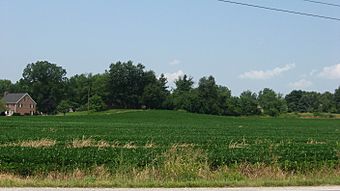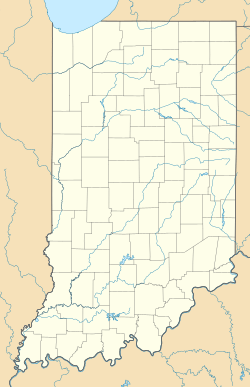Ellerbusch Site facts for kids
Quick facts for kids |
|
|
Ellerbusch Archeological Site (12W56)
|
|

Overview of the site from the southeast
|
|
| Location | Atop the bluff northwest of the junction of State Road 662 and Ellerbursch Rd., west of Newburgh, Indiana |
|---|---|
| Area | 0.8 acres (0.32 ha) |
| NRHP reference No. | 91000270 |
| Added to NRHP | March 14, 1991 |
The Ellerbusch Site (also known as 12-W-56) is an important archaeological site in southwestern Indiana. It's special because it's located on a hill, not in a river valley like many other sites from the same time. This site was likely settled by people from the nearby Angel Site during peaceful times. They might have moved here to be closer to resources. Studying Ellerbusch helps us learn more about how these ancient people lived and settled in the area. Because of its historical value, it was named a historic site in the late 1900s.
Contents
Discovering Ellerbusch
The area around Ellerbusch is rich in ancient history. In 1954, a quick search didn't find Ellerbusch itself. However, it did find four other large sites nearby. One of these was a village located by the river, about half a mile southwest of where Ellerbusch was later found.
Digging Up the Past
The first digs at the Ellerbusch Site were done by the Ellerbusch family, who owned the land. They worked with their neighbors, George and Francis Martin. The Martins were connected to the Glenn Black Laboratory of Archaeology at Indiana University in Bloomington.
In 1957, with help from a university student, they uncovered one house site. They also found part of another house and a pit filled with decorated potsherds. This first dig was written about the next year. Not much more digging happened in 1958 and 1959. Only a very small dig took place in 1962.
In 1973, a student named Thomas J. Green started looking into digging at Ellerbusch again. The Black Laboratory wanted to study a small site in detail. They hoped to learn about the daily life, community structure, and when these smaller sites were used. Studying a small site like Ellerbusch was important. It helped archaeologists understand how large centers like Angel Mounds connected with smaller villages around them.
Green chose Ellerbusch for several reasons. It was on a hill near a lake and close to Angel Mounds. Also, almost all the artifacts found belonged to the owners. This meant all discoveries could be kept together. Previous digs also showed that houses here were not rebuilt many times, unlike at Angel Mounds.
What Was Found at Ellerbusch
Archaeologists found many interesting things at the Ellerbusch Site. These discoveries help us understand the people who lived there long ago.
Early Finds
The first digs by the Ellerbusch family and Martins found 129 pieces of pottery. These included different types, like sandy pieces and cord-marked ones. They also found 23 stone tools, mostly knives. Small pieces of mica and cannel coal were also discovered.
Based on the pottery, it was thought the site was mainly used during the Middle Woodland period. This was a time influenced by Hopewellian peoples. Some pottery even seemed linked to the Swift Creek culture from Georgia.
Pottery Discoveries
Later digs by Green showed that most artifacts were found near the surface. By 1977, diggers had found 3,466 pieces of pottery. About 582 pieces were from the Woodland period. The rest, 2,884 pieces, were from the Angel Phase. Over 98% of these were plain, shell-tempered pottery.
This is similar to pottery found at Angel Mounds. There, less than one percent of pottery had decorations. At Ellerbusch, only six pieces had red paint or negative painting. Most pottery pieces found were small. Only 19 pieces were large enough to tell the shape of the original pot. This made it hard to guess how many pots were once at the site. The small size of the pieces was likely due to repeated plowing over the years.
Stone Tools and Objects
Almost all non-pottery items found by 1977 were stone tools or parts of them. Green reported finding 3,907 stone artifacts in total. Sadly, most of these were found on the surface. This shows how much damage plowing and nature had caused.
More than 3,800 stone artifacts were chipped stone pieces. Three out of four of these were simple lithic flakes with no changes after they were made. They also found 124 projectile points (like arrowheads) and 164 pieces that seemed to be parts of other points.
Other chipped stone tools included knives, drills, and scrapers. One shredder, a tool for tearing, was also found. Many flakes showed signs of being part of hoes, used for farming. Ground stone tools were also found. These included pestles, nutting stones, and hammerstones. Other interesting items were two Woodland gorgets (neck ornaments), a copper bead, and a small pipe. This type of pipe was common at Angel Mounds.
Ancient Homes
In 1973, archaeologists dug up the house site the Ellerbusch family had found earlier. It looked like two houses had been built there, one right after the other. Both were about the same size (22 by 19 feet or 19 by 19 feet). They also faced the same direction.
These houses likely had walls made of vertical posts set in trenches. Only one pit, probably a hearth (fireplace), was found inside a house. Another house site dug in 1973 had been home to three or four different houses over time. This second house site had ten nearby pits and a pile of stone chips. These chips were made of chert, a type of stone found in Harrison County.
The houses were not all the same shape. It seems different types of houses were built at different times. Parts of other structures, including two more houses, were also found. However, plowing had damaged many of these remains. All the houses were generally rectangular. Their sides were built first, and the corners were either filled in or left open as doorways. No openings that looked like doorways were found on the sides of the houses.
The presence of these houses suggests Ellerbusch was a farming village, not just a hunting camp. Stone tools could be used for hunting, but building houses a few miles from Angel Mounds would be a lot of work for hunters. For farmers who stayed in one place, it was a good investment.
Other Discoveries
A group of small pits was found at the site. They might have been used for storage, but their small size suggests they were more likely for trash. Unlike many Mississippian sites, the houses at Ellerbusch seem to have been built simply on the ground surface. There was no sign of specially prepared floors below the ground.
Studying the site was difficult due to two main reasons. First, because it was on a hill, rain and modern plowing had mixed up artifacts from different time periods. This made it hard to know their original context. Second, the soil was very acidic. This meant that only one bone survived from all the animal materials that were once there.
Ellerbusch and Angel Mounds
The Ellerbusch Site's location near the Ohio River is typical for Angel Phase communities. These groups often lived on terraces above the floodplains of rivers. They liked floodplains because they were very fertile. Upland areas dry out faster and are more prone to erosion. Without modern farming methods, upland fields would quickly lose their richness.
People of the Angel Phase also used wood for fuel. Living near a river made it easy to find wood, especially driftwood. River villages also had easy access to water for drinking and washing. They could also add fish and animals that came to the river to their diet.
The Angel Site was the main settlement in the region. Smaller villages like Ellerbusch were built for efficiency. If everyone lived at Angel, they would spend too much time walking to distant fields. By building villages among the fields, people saved a lot of time. The upland area around Ellerbusch was also good for short-term farming. The soil there was easy to farm and could be as fertile as floodplains.
Warfare was the main reason these smaller sites didn't spread further. The Angel Phase people often fought with other groups. They needed to be able to go to the protected Angel Site, which had a fence around it. This meant small villages like Ellerbusch were used more during peaceful times. While Ellerbusch didn't fully explain some things at Angel Mounds, it helped us understand even smaller sites better.
When Was Ellerbusch Used?
Scientists used radiocarbon dating to find out when people lived at Ellerbusch. Two dates came back: between AD 200-320 and between 990-1110. At first, the AD 200-320 date was thought to be a mistake. However, later studies, including by Green himself, saw this early date as proof of a Woodland period occupation at the site. The later date (990-1110) seemed a bit early for the Mississippian period but was similar to other early Mississippian sites in the area.
What Kind of Site Was It?
Green called Ellerbusch a "hamlet." He used this term for Angel sites that had:
- Sizes between 0.5 and 1 acre.
- Only a few artifacts found on the surface.
- Remains of houses.
- Signs of activities like hunting, farming, and gathering.
- An estimated population of 10 to 25 people.
By defining Ellerbusch as a hamlet, Green could estimate its population. He then used this to guess the population of other similar hamlets. Earlier studies suggested that households had about five members. Evidence at Ellerbusch showed that only two or three of its four houses were used at any one time. This would mean 10 to 15 people lived there. Slightly larger populations were suggested for hamlets twice the size.
A hamlet's lack of many artifacts on the surface showed that its residents didn't greatly change the land around them. In 1977, out of 68 known Angel Phase sites, Green classified six as hamlets.
Ellerbusch's Importance
In early 1991, the Ellerbusch Site was added to the National Register of Historic Places. This shows how important it is as an archaeological site. It is one of three archaeological sites in Warrick County listed on the Register. The others are a small part of the Angel Site and the entire Yankeetown Site, which is located along the Ohio River to the southeast.



